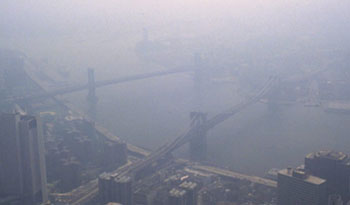The EPA is being crushed by lawsuits right now.
That’s because it issued two final rules in October – on power plant emissions and ozone (smog) regulations.
Coal miner Murray Energy filed lawsuits on both regulations, calling them "exorbitantly expensive, illegal and job-killing." Senator Jim Inhofe (R-OK) plans to pursue legislation to protect American taxpayers from EPA’s aggressive regulatory agenda."
Imagine if the final ozone rules went as far as the American Lung Association, American Medical Association, American Academy of Pediatrics, American Thoracic Society, American Heart Association and others wanted!
As opposed to EPA’s small decrease, lowering acceptable levels of smog from 75 to 70 parts per billion (ppb), health and environmental groups want it reduced to 60 ppb. EPA initially proposed 65-70 ppb, and after the comment period, said it might further lower them to 60 ppb.
"The scientific record clearly shows that a standard of 60 ppb would provide the most public health protection," as levels of 75 ppb put as many as 186 million Americans at risk, says Harold Wimmer, American Lung Association CEO. EPA’s Clean Air Scientific Advisory Committee concurs after reviewing 1000 studies published since 2008.
At 75 ppb, smog poses serious health threats to people, aggravating asthma and respiratory disease, and heart attacks. It harms ecosystems by damaging plants’ ability to photosynthesize, stunting tree growth, and it also reduces farm yields.

Ground level ozone is created by chemical reactions between nitrogen oxide and volatile organic compounds (VOC) in the presence of sunlight. Sources include cars, trucks, buses, industrial facilities, power plants and chemical solvents and paints.
Meanwhile, "depending on the severity of the ozone problem, areas would have until between 2020 and 2037 to meet the standards," says EPA spokeswoman Melissa Harrison.
Other rules recently finalized protect farmworkers and people who live nearby from pesticides; reduce cancer-causing air pollutants at our nation’s 142 large oil refineries; and restrict power plants from dumping toxic pollutants into waterways, such as mercury, arsenic, lead, and selenium.
Currently, power plants pollute about 23,600 miles of rivers and streams each year with 79,200 pounds of arsenic, 65,000 pounds of lead, and 3,000 pounds of mercury, says EPA.
While the coal industry in particular believes many of these rules are directed at them, the fact is many merely close exemptions the industry has enjoyed for decades through lobbying and lawsuits. If the industry cleaned up its act long ago, regulations wouldn’t be necessary.
Read our articles, Give EPA Some Credit: US Has Cleaner Air and EPA Ranked Most Effective of All Federal Agencies.
